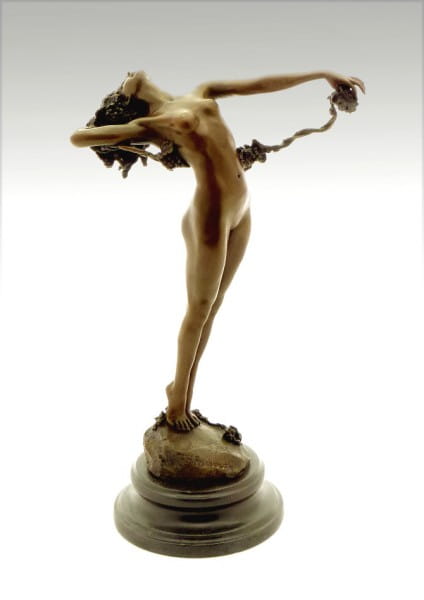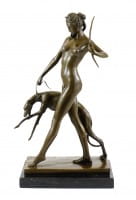Prices incl. VAT, free shipping worldwide
Ready to ship today,
Delivery time appr. 3-6 workdays










Product description
"Harriet Frishmuth Bronze - The Vine - signed 1923"
| Weight | 3,5 kg |
The Vine – Exultant Bronze Sculpture by Harriet Whitney Frishmuth
The Vine is at once a dancer and a melody made three-dimensional. The figure’s poised foot and arched back suggest a crescendo in motion, as if she is spinning through a silent concerto. Frishmuth’s genius lay in her ability to translate the invisible rhythms of music and the poem of dance into solid bronze. Each curve of the model’s body resonates with vitality, every twist a note in a symphony of grace. In this way, Harriet Whitney Frishmuth The Vine becomes both subject and performer in an intimate duet of art and life.
From Blossoming Beginnings in Philadelphia
Harriet Whitney Frishmuth entered the world on July 5, 1880, in Philadelphia, Pennsylvania, at a time when American art was seeking its own voice beyond European academies. Trained at the Pennsylvania Academy of the Fine Arts under the tutelage of Thomas Eakins, she later ventured to Paris to study with the celebrated Auguste Rodin. It was these dual influences—from Philadelphia’s rigorous realism to Paris’s bold expressiveness—that shaped her into the singular sculptor we recognize today as Harriet Whitney Frishmuth, whose creations so vividly celebrate the human spirit in motion.
A 1923 Masterpiece of Joyful Abandon
Early in 1923, Frishmuth unveiled The Vine, a sensuous bronze that captured both the elegance of Art Nouveau and the dynamism of Jazz Age modernity. Cast in Paris and expertly finished in the United States, this bronze stands as a testament to her mastery of fluid form. Signed by the artist, Harriet Frishmuth Bronze works like this one offered collectors a rare blend of classical modeling and contemporary verve, elevating her reputation across both continents.
Celebrating the Feminine Form
Frishmuth’s devotion to the female body was revolutionary for her time. She eschewed the rigid, formulaic conventions of earlier sculptural nude forms and embraced a more liberated, naturalistic ideal. In The Vine, the dancer’s slender waist, elongated neck, and lifted arms convey an almost ethereal weightlessness, while her strong legs root her firmly in reality. This union of strength and delicacy became a hallmark of Harriet Frishmuth Bronze creations, earning her acclaim as a pioneer of modern figurative sculpture.
An Artist’s Journey Through Time and Space
Though often associated with Parisian ateliers, Frishmuth maintained a lifelong connection to her American roots. After studying in France, she returned to New York, where she established her own studio and continued to exhibit at the National Academy of Design and the Art Institute of Chicago. Her transatlantic experiences infused her work with a cosmopolitan flair that bridged Old World elegance and New World optimism. The Vine thus stands not only as an artwork but as a symbol of cultural synthesis in the early 20th century.
Technical Brilliance in Bronze
Frishmuth’s technical command of the lost-wax casting process is evident in every polished plane and finely sculpted detail of The Vine. The soft sheen of the patina highlights the dancer’s musculature and the gentle undulation of her drapery-like vine tendrils. The play of light across her form evokes both the shimmer of moonlight on skin and the warm glow of gilded décor, reinforcing the sculpture’s dual nature as both intimate portrait and decorative marvel. Her meticulous finishing is why Harriet Frishmuth Bronze pieces continue to captivate collectors and museums alike.
A Legacy of Movement and Inspiration
Harriet Whitney Frishmuth’s career spanned six decades, during which she produced more than 50 editions of The Vine and numerous other celebrated works such as Forever Free and The Bubble. Her enduring impact on the canon of American sculpture is measured not only by her technique but by her unflinching devotion to capturing the joy and freedom of human movement. She became a mentor to younger artists and a beacon for women in the arts, ensuring that her vision would outlast the generations she helped inspire.
Embracing Eternal Spring in Bronze
The Vine was more than a fleeting dance frozen in metal; it was Frishmuth’s declaration that art could capture both the ephemeral and the eternal. In every viewing, one senses the crispness of a spring morning, the promise of life unfolding. The dancer’s joyous ascent, her vine-like adornments coiling around her body, invite the viewer into a world where beauty and motion are inseparable. This is the power of Harriet Whitney Frishmuth The Vine—an artwork that never ceases to whisper the timeless song of the human soul.
Height: 40 cm
Width: 23 cm
Depth: 13,5 cm
Weight: 3,5 kg
100% Bronze
Our advantages
free shipping
Worldwide free shipping
14 days money back
You can cancel your order
within 14 days
secure payment services
Paypal, Master Card, Visa, American Express and more



























































